| Srl | Item |
| 1 |
ID:
189788


|
|
|
|
|
| Summary/Abstract |
TODAY, amid accelerated globalization and the informatization of society, one of the most urgent tasks for states is to form a positive obraz [image, figure, representation - Trans.] and increase competitiveness in the international arena. Like any other country, Russia strives for recognition in the world. However, the approaches to the development of our country's foreign policy image have varied significantly at various stages of the country's development. In this regard, study of the peculiarities of the evolution of the concept of a country's imidzh [a Western borrowing that has a more restricted usage in the fields of politics and public relations - Trans.], its content, and methods of formation, is of particular interest.
|
|
|
|
|
|
|
|
|
|
|
|
|
|
|
|
| 2 |
ID:
166634
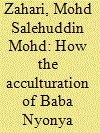

|
|
|
|
|
| Summary/Abstract |
The migration of the Chinese community to Malacca in the 16th century has enabled the process of cross culturing and culinary acculturation, producing a unique mixture of Baba Nyonya food. Even though Baba Nyonya food is pretty much has been localised (Malay), its Chinese representation cannot be denied. This study aims to assess how the acculturation of the Baba Nyonya community affects Malacca food identity. A quantitative methodology is employed in this study. This study classifies Baba Nyonya food acculturation through (1) types of food; (2) methods of cooking; (3) ingredients; and (4) eating decorum. From the regression analysis, this study found that Baba Nyonya cultural polarity explains significant variation in the formation of Malacca food identity. This study then elaborates on the importance of Baba Nyonya food in Malacca destination branding.
|
|
|
|
|
|
|
|
|
|
|
|
|
|
|
|
| 3 |
ID:
173278


|
|
|
|
|
| Summary/Abstract |
An image of a country means its perception by other countries, by their governments and population, and may be a product of its domestic social and economic processes but may also be determined by this country's foreign policy principles and its systemic and consistent demonstration of its victories and achievements in the international arena.
|
|
|
|
|
|
|
|
|
|
|
|
|
|
|
|
| 4 |
ID:
190178


|
|
|
|
|
| Summary/Abstract |
In Central Asia the European Union (EU) positions itself as a benign and gentle actor with no geopolitical intentions. But is this self-prescribed image of a ‘force for good’ shared by Central Asians? To answer this question, the article scrutinizes whether the EU is perceived as posing a threat to or offering an opportunity in Kazakhstan and Kyrgyzstan. Theoretically it is argued that the EU cannot unilaterally claim a certain role in the region; rather, perceptions held by Central Asians partly determine what kind of actor the EU can be and what kind of policies it can successfully implement. The article finds that opportunity/threat perceptions are highly issue specific. Depending on a particular issue area, the EU’s image may change from that of an opportunity to a threat, or vice versa. Yet, the opportunity aspect visibly prevails in both countries, which can be regarded as the EU’s comparative advantage vis-à-vis other actors in the region.
|
|
|
|
|
|
|
|
|
|
|
|
|
|
|
|
| 5 |
ID:
127101
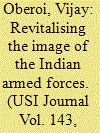

|
|
|
| 6 |
ID:
138471
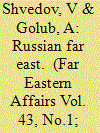

|
|
|
|
|
| Summary/Abstract |
The article examines the image of the Russian Far East and initial methods of revealing it. Questionnaire materials are cited and the results of polls are analyzed. Specific features of respondents' assessment of the territory of their residence are summed up.
|
|
|
|
|
|
|
|
|
|
|
|
|
|
|
|
| 7 |
ID:
100606


|
|
|
|
|
| Publication |
2010.
|
| Summary/Abstract |
THE IMAGE OF MODERN RUSSIA is at present still in the formative stage, gradually transforming into a stable and solid system capable of standing up to the negative impacts of the media environment. Such incompletion, not infrequently coupled with a lack of effective interaction between elements in this system, still leaves a vast information vacuum that is actively being filled with assessments and interpretations that are far from objective and sometimes openly hostile to Russia's interests. As they build up, these negative elements create a basis for the development of false perceptions about our state's position on the international arena and the specifics of its political, economic, and social development.
|
|
|
|
|
|
|
|
|
|
|
|
|
|
|
|
| 8 |
ID:
189143
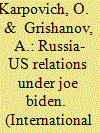

|
|
|
|
|
| Summary/Abstract |
A YEAR ago, the 46th US president stirred up diametrically opposed emotions and expectations in the unprecedentedly polarized and divided US. Supporters and fellow Democrats viewed the new president as an incredibly experienced leader who would consolidate the nation and return it to leading positions in the community of nations aligned with the values of the "collective West." Biden's critics and opponents who sympathized with Donald Trump spoke of the new president as an anachronism who could not make a decision on his own and was controlled by party functionaries. Opinion in the rest of the world was similarly divided. Today, however, we can say that, as usual, the truth lies somewhere in the middle.
|
|
|
|
|
|
|
|
|
|
|
|
|
|
|
|
| 9 |
ID:
157784
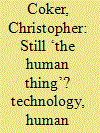

|
|
|
|
|
| Summary/Abstract |
Is war beginning to escape human control? Thucydides tells us the war is one of the things that makes us definitively human; but how long will this continue to be the case as our relationship with technology continues to develop? Kenneth Waltz’s book Man, the State and War affords one way of answering that question. So too does Nikolaas Tinbergen’s framework for understanding human behaviour and Bruno Latour’s Actor–Network Theory (ANT). The main focus of this article is the extent to which we will diminish or enhance our own agency as human beings, especially when we come to share the planet with an intelligence higher than our own.
|
|
|
|
|
|
|
|
|
|
|
|
|
|
|
|
| 10 |
ID:
169910
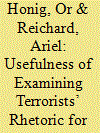

|
|
|
|
|
| Summary/Abstract |
This study advances a distinction between two generic types of terrorists’ rhetoric: (1) ideological rhetoric candidly reflecting the terrorists’ genuine beliefs and values regarding their military targeting policy (who is a legitimate target), even when adopting such rhetoric involves high image/diplomatic costs; and (2) a PR-oriented rhetoric which consciously misrepresents the terrorists’ intentions and behavior in an attempt to project a more benign and humane image, thus maintaining sympathy and rebuffing criticism. We contend that such a distinction can provide a highly useful metric for assessing terrorists groups’ rationality and pragmatism: the most pragmatic groups will shift between these two types of rhetoric depending on changing strategic needs. To show the practical usefulness of this distinction we provide criteria for categorizing terrorists’ rhetorical responses to (mostly liberal-minded) criticism that they have killed innocent civilians in their enemy’s camp. We apply our criteria by examining terrorists’ (sincere and insincere) apologies.
|
|
|
|
|
|
|
|
|
|
|
|
|
|
|
|
| 11 |
ID:
123787


|
|
|
|
|
| Publication |
2013.
|
| Summary/Abstract |
The dramatic growth of drone warfare in the last decade has meant the arrival of a new kind of war imagery in civilian life: the view through the drone camera. As such, the drone is not simply a weapon, but also an emerging medium for representing conflict. This article explores the ways this imagery has been selected, interpreted, framed and put to use in public and popular culture. In addition to exploring how these practices of looking fit within the larger history of war imagery, two prominent features of 'drone vision' are identified: the promotion of consumer interactivity in the drone war and the militarising of domestic space.
|
|
|
|
|
|
|
|
|
|
|
|
|
|
|
|
| 12 |
ID:
084935


|
|
|
|
|
| Publication |
2008.
|
| Summary/Abstract |
Why do American presidents, when engaged in military coercion, sometimes bluff or exaggerate their resolve and other times do not? Bluffing increases the likelihood and lowers the cost of success, so a failure to bluff provides an intriguing puzzle. It is argued here that American presidents are more likely to bluff resolve when they face an opposition with a dovish public image, and when that opposition perceives a low likelihood that the adversary will call its bluff. The analysis of presidential signalling of resolve in Kosovo and Iraq supports claims by Kenneth Schultz that the opposition party has a tendency to expose presidential bluffing. I also show, however, that the opposition is significantly more likely to expose presidential bluffing when its party has a hawkish image - the public perception of the party's competence on national security and its willingness to use force - and when the opposition perceives a high probability that the bluff will be called. When the president knows the opposition is likely to expose a bluff, it makes sense for him to refrain from overstating resolve. Presidential bluffing is likely to occur when the opposition party has a dovish public image and when the opposition perceives a low probability that the bluff will be called. These findings have direct implications for American leaders and American threats to use force after the end of the George W. Bush presidency.
|
|
|
|
|
|
|
|
|
|
|
|
|
|
|
|